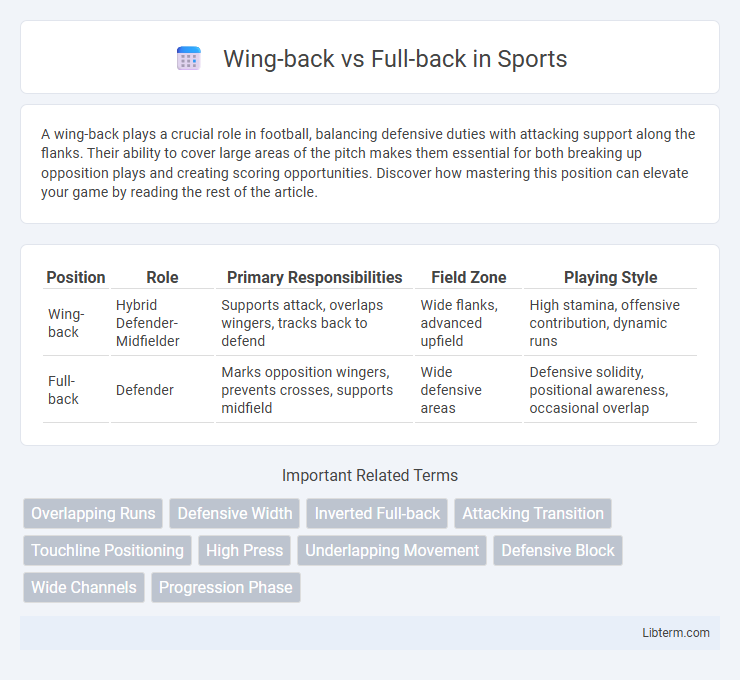A wing-back plays a crucial role in football, balancing defensive duties with attacking support along the flanks. Their ability to cover large areas of the pitch makes them essential for both breaking up opposition plays and creating scoring opportunities. Discover how mastering this position can elevate your game by reading the rest of the article.
Table of Comparison
| Position | Role | Primary Responsibilities | Field Zone | Playing Style |
|---|---|---|---|---|
| Wing-back | Hybrid Defender-Midfielder | Supports attack, overlaps wingers, tracks back to defend | Wide flanks, advanced upfield | High stamina, offensive contribution, dynamic runs |
| Full-back | Defender | Marks opposition wingers, prevents crosses, supports midfield | Wide defensive areas | Defensive solidity, positional awareness, occasional overlap |
Understanding the Roles: Wing-back vs Full-back
Wing-backs operate as hybrid players combining defensive duties with advanced attacking roles, often positioned higher up the pitch to provide width and crosses. Full-backs primarily focus on defensive responsibilities, protecting the flanks and supporting the center-backs while occasionally overlapping. Understanding the tactical deployment of wing-backs versus full-backs helps distinguish their influence on team shape, pressing intensity, and offensive support.
Historical Evolution of Full-backs and Wing-backs
Full-backs originated in early football formations as defensive players positioned wide to prevent opposition wingers from advancing, primarily focusing on marking and tackling. The evolution of the wing-back emerged with tactical innovations like the 3-5-2 formation, blending defensive duties with increased offensive responsibilities, enabling wider attacking options and overlaps. This historical shift reflects football's broader trend towards dynamic, multifunctional roles where wing-backs contribute both to defense and attack, contrasting with the traditionally conservative full-back role.
Key Tactical Differences
Wing-backs operate primarily as both defenders and wide midfielders, providing width in attack and supporting forward play with overlapping runs, while full-backs focus more on defensive duties, maintaining the defensive line and marking opposition wingers closely. Wing-backs typically play in formations such as 3-5-2 or 5-3-2, allowing them to push higher up the pitch and contribute to offensive phases, whereas full-backs are integral to traditional back four setups like 4-4-2 or 4-3-3, where defensive solidity is prioritized. The key tactical difference lies in wing-backs' advanced positioning and offensive responsibilities compared to full-backs' primary focus on defense and maintaining team shape.
Defensive Responsibilities Compared
Wing-backs, positioned higher on the pitch, have a dual role involving both attacking support and defensive coverage along the flanks, requiring constant tracking back to assist center-backs during opposition attacks. Full-backs primarily focus on defensive duties, consistently marking wingers, blocking crosses, and intercepting passes to prevent opponents from penetrating wide areas. The distinction lies in wing-backs balancing overlapping runs with defensive transitions, while full-backs prioritize maintaining a solid defensive line and minimizing space behind the defense.
Attacking Contributions: Advanced Roles Explained
Wing-backs operate higher up the pitch, combining defensive duties with significant attacking contributions by providing width, delivering crosses, and supporting forward plays. Full-backs traditionally prioritize defensive responsibilities but have evolved to participate in offensive phases, often overlapping midfielders and creating goal-scoring opportunities. Tactical formations like 3-5-2 utilize wing-backs for advanced attacking roles, whereas 4-4-2 systems favor full-backs with more balanced defense-offense duties.
Physical and Technical Demands
Wing-backs require exceptional stamina and speed to cover the entire flank, seamlessly transitioning between defense and attack, while full-backs prioritize strong defensive positioning and tackling skills with moderate forward runs. Physically, wing-backs endure higher aerobic demands due to constant up-and-down sprints, whereas full-backs focus more on strength and agility to resist opposing wingers. Technically, wing-backs excel in crossing accuracy and dribbling under pressure, contrasting with full-backs who emphasize interception, marking, and clearances in tight spaces.
Formation Suitability: When to Use Each
Wing-backs excel in formations like 3-5-2 or 3-4-3, where their dual role in attack and defense supports wide midfield dominance and wing play. Full-backs are ideal for formations such as 4-4-2 or 4-3-3, providing solid defensive coverage on the flanks while supporting forward runs without the high attacking responsibility of wing-backs. Choosing between wing-back and full-back depends on tactical emphasis: wing-backs suit systems requiring width and offensive overload, whereas full-backs fit balanced formations prioritizing defensive stability.
Modern Examples of Top Wing-backs and Full-backs
Modern wing-backs such as Trent Alexander-Arnold of Liverpool and Alphonso Davies of Bayern Munich excel in advanced wide positions, combining defensive duties with creative attacking contributions through overlapping runs and precise crosses. In contrast, full-backs like Andrew Robertson and Achraf Hakimi prioritize defensive solidity while supporting build-up play and occasionally joining attacks, balancing defensive responsibility with offensive support. The evolving roles are epitomized by these players' tactical versatility, showcasing how wing-backs often serve as auxiliary wingers, whereas full-backs maintain a more traditional defensive role with offensive bursts.
Impact on Team Shape and Balance
Wing-backs provide width in formations like 3-5-2, enabling teams to maintain offensive pressure while covering wide areas defensively, thus enhancing both attack and team shape. Full-backs in traditional 4-4-2 or 4-3-3 systems prioritize defensive solidity, often staying deeper to support center-backs, which helps maintain a compact defensive structure. Wing-backs demand high stamina and tactical discipline to balance attacking runs with defensive duties, affecting overall team balance more dynamically than full-backs.
Choosing the Right Option for Your Squad
Selecting between a wing-back and a full-back depends on your squad's tactical setup and player attributes. Wing-backs thrive in formations like 3-5-2, offering width and attacking support with stamina and crossing ability, while full-backs suit a back four, emphasizing defensive solidity and positional discipline. Assess your team's balance, opponent threats, and match tempo to decide which role maximizes both defensive coverage and offensive contribution.
Wing-back Infographic

 libterm.com
libterm.com